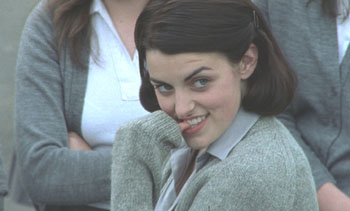![[Metroactive Movies]](/movies/gifs/movies468.gif)
[ Movies Index | Show Times | Silicon Valley | Metroactive Home | Archives ]
Sisters Act
Straying girls end up imprisoned by nuns in Peter Mullan's 'The Magdalene Sisters'
By Richard von Busack
DUBLIN IS FULL of tragic monuments. One of the saddest is seen under the titles of Peter Mullan's The Magdalene Sisters. This monument doesn't commemorate something the nation endured during the British occupation but rather an atrocity committed by the Irish upon the Irish. Some 30,000 women passed through the Magdalene Asylums between the time the convent-run laundries were set up in 1848 and when they were closed in 1996. What began as a shelter for unwed mothers became a series of unregulated prisons. The Archdiocese of Dublin profited off the toil of the women. Frances Finnegan's book on the subject is titled Do Penance or Perish. Actually, the Magdalene interns did both.
The word "maudlin" comes from old religious images of St. Mary Magdalene, Jesus' companion, always shown weeping over her former whoredom. But The Magdalene Sisters is anything but maudlin. Scottish director Mullan, who, as an actor, starred in Ken Loach's My Name Is Joe, goes against the frequent neglect of visual storytelling in Irish cinema, usually sacrificed in favor of a clever script.
By "visual," I don't mean the inclusion of pretty Galway landscapes. Mullan's visual storytelling shines early as the opening sequence. Word of a girl's rape goes around a room in which music is blaring, and we see the whispering. The whole room knows of the girl's shame before her tears are dry. And almost instantly, the car from the Magdalene Asylum has come for her.
Mullan then passes on to the backstory of Rose (Dorothy Duffy), who has just given birth to an illegitimate child. Her mother is rigid with scandal. When the baby is taken away promptly, Mullan blocks the site of Rose's anguish with her father's back, as he stands between her and the departing child.
Mullan outlines the story through a quartet of girls locked up together in 1964: Rose; Margaret (Anne-Marie Duff), who we see raped by her cousin during a wedding; the gentle, slow-witted Crispina (Eileen Walsh); and Bernadette (Nora-Jane Noone). Crispina is the saddest casualty; she won't lose her religious faith despite what the nuns, and one of the priests, are doing to her.
As in the old prison pictures, there's a tough one. She's the one we follow the closest, because she's the one we'd want to be if we were walled up. Noone's Bernadette is jailed for nothing worse than just being a provocative teasing girl, for driving boys crazy by staring at them and gnawing on her thumb.
Noone's anti-heroic toughness is gripping to watch. You're convinced she can't be broken, despite the barred windows, the endless loads of laundry, the petty, mingy rules and the vicious punishments (the nuns like to shave heads and sell the hair to wig makers). As an orphan, used to institutions, Bernadette is equipped to survive.
Certain type of faces go in and out of style, depending on the decade. Noone looks like the early-1960s English film-star type. She's black Irish, with a crooked, arrogant mouth; her large eyes seem as mocking as Paul McCartney's did in the Richard Lester films. In her diffident strut, the curl of her heavy eyebrows, there's something of the young Sean Connery.
Geraldine McEwan, the veteran Shakespearean actress, plays Sister Bridget. McEwan brings us layers of the head of the order. Certainly, she's an insane religious bigot, but she also reveals a girlishness she hoards, just as she hoards the rolls of currency her order has made by the girls' slave labor.
Sister Bridget is thrilled to her bones at the one big event in the interned girls' life. It's a once-a -year movie night featuring that chestnut The Bells of St. Mary's, with Ingrid Bergman taking the veil, and the film brings her to burbling tears. Mullan's dry, dirty sense of humor shows in this ironic moment, and in other scenes: such as the scene in which the priests are hurling prayers and holy water at a new industrial dryer.
The Vatican has denounced The Magdalene Sisters as a "rancorous provocation"; that's advertising you couldn't buy. What happened to the women in the Magdalene Asylums may have only been possible under a government that was tied up with its church, and that's why the worst Catholic scandals have emerged in such different places as Ireland, Quebec and Boston.
At the end of the film, when you see a couple of girls freed, in modern dress, it's a shock. That this kind of Victorian torment could have been happening within living memory makes these emerging horror stories something like the Berlin Wall falling. This isn't a film that's depressing but good for you; it has the exquisite tension of Midnight Express--and it's smarter.
[ Silicon Valley | Metroactive Home | Archives ]
![]()

Nun of the Above: Nora-Jane Noone gives a star-making performance as a rebellious girl locked up in a religious asylum.
The Magdalene Sisters (R; 119 min.), directed and written by Peter Mullan, photographed by Nigel Willoughby, and starring Geraldine McEwan, Anne-Marie Duff and Nora-Jane Noone, opens Friday at selected theaters valleywide.
Send a letter to the editor about this story to letters@metronews.com.
From the August 21-27, 2003 issue of Metro, Silicon Valley's Weekly Newspaper.